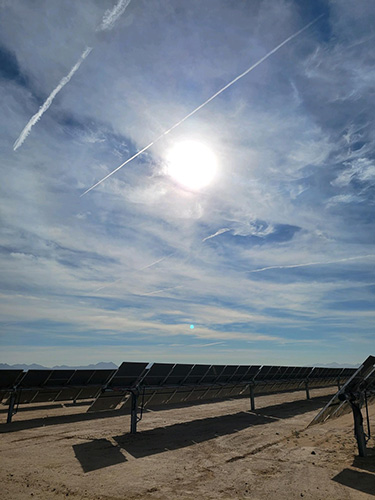PV string harness technology is not a place to cut corners or opt for low quality.

By Starr Yu, Solar Product Manager at Amphenol TPI
String harnesses may not be the first thing one thinks of when installing a new solar power system, but they play a crucial role in the power generation process.
Installing a new solar power system can be a lofty undertaking, with hours of strenuous labor and high costs along the way. One way people may try to lighten those loads is through cutting costs wherever they can. When attempting to identify an easy place to bring those costs down, photovoltaic (PV) wiring string harnesses could appear to some as a prime candidate to go for a cheap alternative.
However, it cannot be stated strongly enough that these harnesses are not the place to try to cut corners, as their susceptibility to decay requires not only the use of high-quality equipment that has been rigorously tested. Lackluster testing or utilization of subpar equipment can result in cumbersome issues that lead to system malfunctions that require costly repairs and can even pose considerable personal danger to anyone interacting with the solar power system.
Here’s what you need to keep in mind when assembling and installing your PV system’s string harnesses:
Part of the reason string harnesses may seem like such an ideal candidate for equipment cost savings or quick installation might be due to a lack of knowledge around them. These harnesses allow for the transfer of direct current (DC) power from arrays of PV panels to the next phase of the power transmission, which is typically a combiner box or inverter, in an environmentally sealed fashion.

As part of the DC collection system, string harnesses are made from cable and connectors designed for solar power applications that are augmented with molded junctions and fuses. One of the key roles these harnesses play within a solar power system is minimizing power loss over the vast length of cable.
Due to their typically large size and scale, string harnesses are often pre-kitted and shipped directly to the implementation site, rather than an interim warehouse.
Discerning a quality string harness can be difficult to eyeball for those that do not know what they need to look for. You should check them for reliably molded junctions and fuses that will help them maintain use for about 40 years. Look for low resistance through all joints and environmental sealing as well.
As with all elements of a solar power system, string harnesses can be exposed to harsh conditions and environments that cause detrimental decay. In the field, they can often be exposed to a mix of UV exposure, chemical and temperature cycling, humidity, precipitation and more, all contributing to material degradation, including shrinkage of the cable jacket that runs over the length of the harness.
If shrinkage and other decay goes unnoticed or without repair, the cables can shrink to the point that they tear, leaving the internal wiring within them exposed, leaving them susceptible to major damages and putting any personnel that comes into contact with them in danger.
This is where proper molding and bonding comes into play. Utilizing equipment with proper molding and bonding preserves the protective coating around the inner wiring, keeping the wires from being damaged or causing harm. Solar installation professionals also ought to avoid harnesses connected with methods more vulnerable to damage and decay from various environmental factors.
Overmolds with permanent bonding to cable jackets typically have superior longevity. Harnesses that use bonding over mechanical sealing eliminate jacket shrinkage and the potential failures from receding cable jackets.
Conversely, solar cables connected through other sealing methods can pull out of the junctions, exposing copper strands. This endangers personnel and can lead to arcing with any tall, dry grass growing near exposed wires. Additionally, wicking can easily occur if moisture gets inside an outer mold that is not fully bonded to the cable, compromising the performance of the fuse or junction.
To maximize string harness performance and safety, it is important to select products that have undergone rigorous testing. Given the importance of material selection for product longevity, buyers ought to:
1. Use products with high RTI values
The Relative Thermal Index (RTI) is of paramount importance when considering fuse holder material selection. RTI assesses the maximum temperature a material can safely withstand for an extended period of time without breaking down. Materials with high RTI values are especially important for surfaces that come into direct contact with fuses.
Fuse holders constructed with high RTI polymers experience much greater longevity than those surfaced with rubber alone.
2. Deploy solar components tested to the most stringent possible interpretation of standards
While RTI standards exist, their guidelines are open for interpretation, meaning that a product may perform differently, even within the guidelines, depending on how the test is administered. For assured confidence in material durability, solar component purchasers ought to seek out products tested by the most stringent standard interpretations. They should also scrutinize the ratings provided by third parties, which sometimes test interpretations of the standards that can lead to dubious consequences..
Again, when putting a brand new solar power system together, string harness installation, testing and equipment quality likely are not at the top of everyone’s priority list. But a solar power system is only as strong as its weakest link and if you choose to skimp out on quality, testing or installation for this seemingly innocuous piece of the solar puzzle, you could not only end up with major repair costs down the road but also put people in genuine danger.

Starr Yu is a solar wiring harness expert with over a decade of experience in the solar industry. Currently serving as the Solar Product Manager at Amphenol TPI, Starr specializes in overmolded solar wiring harnesses. With a passion for innovation and a proven track record in developing cutting-edge solutions, Starr is dedicated to driving forward-thinking strategies that propel organizations to new heights in today’s competitive landscape.
In this episode, I sat down with Beejan Giga, Director | Partner and Caleb Emerson, Senior Results Manager at Carpedia International. We discussed the insights behind their recent Industry Today article, “Thinking Three Moves Ahead” and together we explored how manufacturers can plan more strategically, align with their suppliers, and build the operational discipline needed to support intentional, sustainable growth. It was a conversation packed with practical perspectives on navigating a fast-changing industry landscape.